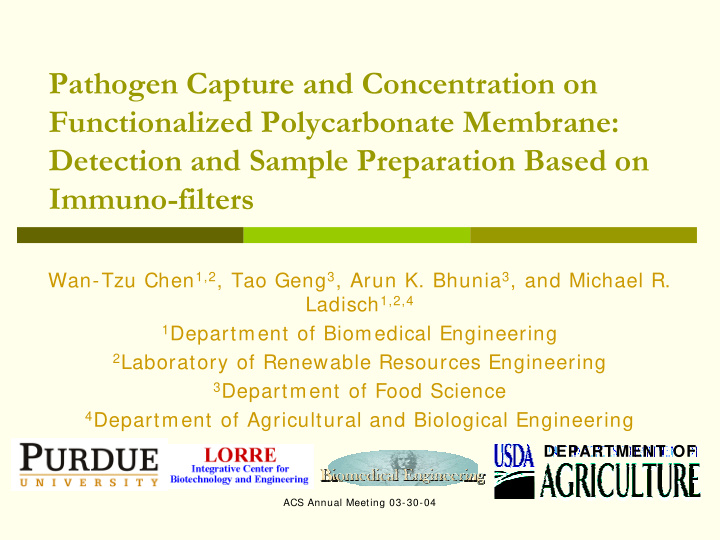



Pathogen Capture and Concentration on Functionalized Polycarbonate Membrane: Detection and Sample Preparation Based on Immuno-filters Wan-Tzu Chen 1,2 , Tao Geng 3 , Arun K. Bhunia 3 , and Michael R. Ladisch 1,2,4 1 Department of Biomedical Engineering 2 Laboratory of Renewable Resources Engineering 3 Department of Food Science 4 Department of Agricultural and Biological Engineering DEPARTMENT OF ACS Annual Meeting 03-30-04
Acknowledgements � Dr. Richard Linton � Dr. Rashid Bashir � Chia-Ping Huang and Dr. Debra Sherman � Dr. J. Paul Robinson and Jennifer Sturgis This research was supported through a cooperative agreement with the ARS of DEPARTMENT OF the United States Department of Agriculture project number 1935-42000- 035
Listeria monocytogenes � Gram-positive, rod-shaped bacterium � Highly resistant to salt and low temperature � Cause listeriosis � Average death rate of 20~ 30 % � Especially harmful for pregnant women � Occur in milk, cheese and ready-to-eat dairy food via post-processing contamination
Conventional Methods � Conventional Sample Preparation Method * � Enrichment broth � Oxford or LPM agars � TSBYE agar � Commonly Used Detection � ELISA-High detection limit � Immunobeads-Small volume � PCR-False-positive results * * � Surface Plasma Resonance * Hitchins AD. 1998, Bacteriological Analytical Manual, AOAC International * * Manzano M et al. 1997, J. Sci. Food. Agric.,74: 25-30
Motivations � Detect low level of foodborne pathogen � In complex and various foods � In quick and precise way � Sample preparation usually is rate-limiting � But less attention is paid in this step � How do w e com bine tw o crucial steps into one?
Our Approach Bacteria Antibodies Membrane
Membrane Candidates Mixed Cellulose Polycarbonate PVDF Nylon
How Concentrated Are They? 100.00 90.00 Polycarbonate 0.4 um 80.00 Mixed cellulose 0.45 um Concentration factors 70.00 Expected concentrated factors 60.00 50.00 40.00 30.00 20.00 10.00 0.00 1 mL 5 mL 10 mL 25 mL 50 mL Filtered volumes (ml)
Chemistry of Antibodies Immobilization C C H O C H O O 3 3 (C H 2 ) C H C O C O C O C N O 4 H N H Poly-L- Lysine, C H C H 3 3 in Na 2 CO 3 C O Polycarbonate Glutaraldehyde in N H 2 (C H 2 ) C H 4 PBS, pH 7.4 N H C O CH 3 C O O CH O 3 (C H 2 ) 4 CH O C O C N H (CH 2 ) CH O C O C N 4 H NH CH 3 NH CH C O Proteins 3 in PBS, pH 7.4 Protein C O (C H 2 ) 3 N CH CH N(C H 2 ) 4 ) CH (CH 2 ) 3 NH CHO CH N(CH 2 ) 4 ) CH Antibody NH P66 or BSA Suye et al., 1998, Biotechnol Appl Biochem. 27: 245-248.
Batch Incubation Study ACS Annual Meeting 03-30-04
Methods Add Bacterial 2 4 -w ell Sam ples Plate P6 6 Mem branes
Antibody Immobilization LG surface + FITC-P66 Membrane+Poly-Lysine+Glutaraldehyde (LG surface)
Spacer and Linker 300 3 4 250 Fluorescence Intensity 200 150 2 100 50 1 0 Blank Blank+FITC-P66 Lysine- Lysine- Glutaraldehyde+ Glutaraldehyde+ FITC-BSA FITC-P66/BSA (Covalent binding) (Covalent binding) Integration time = 8 ms
L. monocytogenes on Different Surfaces Initial= 3.7*10 8 cells Listeria on LG surface– HIGH Listeria on BSA surface- non-specific binding! blocking non-specific binding
Specific Binding BSA Antibody Initial=3.7*10 8 cells Listeria on P66 surfaces Blank LG surface
Non-specific E coli Binding Initial= 3.7*10 8 cells E. Coli on P66 surfaces Blank LG surface
Mixture of Two Bacteria Initial= 3.7*10 8 cells Listeria on P66 surface E coli on P66 surface
Flow-Through Study ACS Annual Meeting 03-30-04
Syring + Holder 5 m l/ m in controlled by syringe pum p PBS containing L.m onocytogenes or E.coli P6 6 Mem brane
Fluorescence Images I nitial= 7 .3 x1 0 7 cells/ m l x 5 0 m l= 3 .7 x 1 0 9 cells 1 2 3 Blank E coli on P6 6 L. m onocytogenes Mem brane Mem brane on P6 6 Mem brane 1 2 3
Fluorescence Intensity 2500 2000 Fluorescence Intensity 1500 1000 500 0 Blank membrane E coli captured by P66 L. monocytogenes membrane captured by P66 membrane Integration time = 250 ms
SEM Images I nitial= 7 .3 x1 0 7 cells/ m l x 5 0 m l= 3 .7 x 1 0 9 cells Blank E coli on P6 6 L. m onocytogenes Mem brane Mem brane on P6 6 Mem brane
Conclusions and Significance � Hydrophilic spacer and cross-linker helps antibody immobilization � Selective capture for batch incubation � Mixture of two different bacteria can be differentiated � Bacteria concentration and selective capture can carry out simultaneously � Real-time concentration and detection can be achieved within an hour
Questions?
Recommend
More recommend